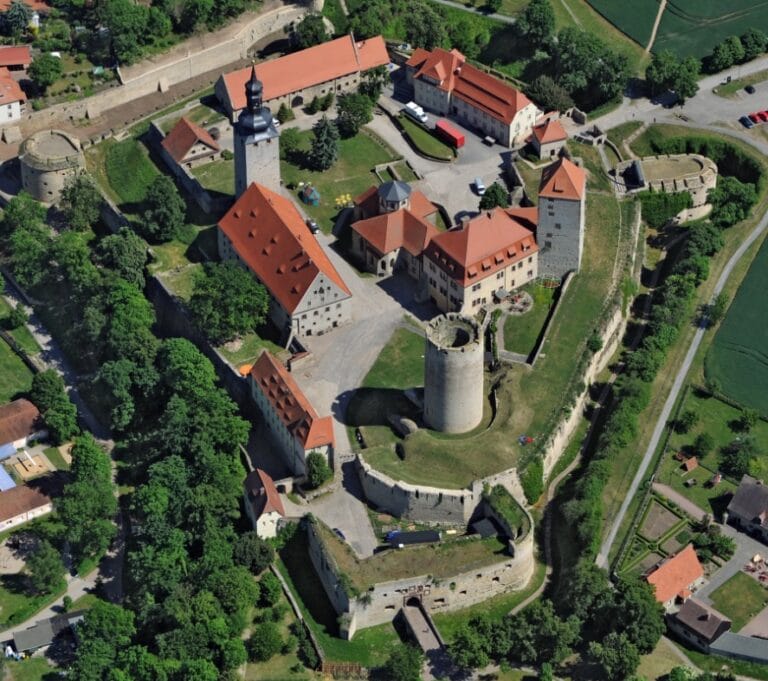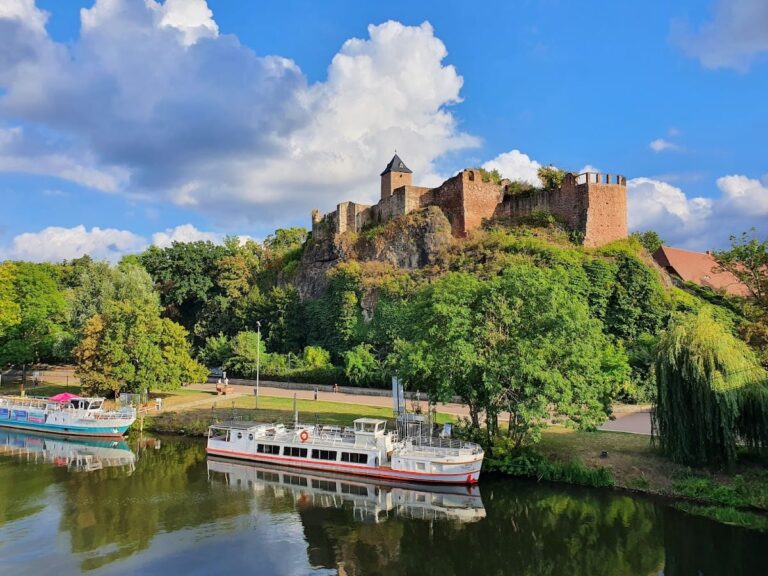Burg Schraplau: A Medieval Hill Castle Ruin in Germany
Visitor Information
Google Rating: 3
Popularity: Very Low
Google Maps: View on Google Maps
Country: Germany
Civilization: Unclassified
Remains: Military
History
Burg Schraplau is a hill castle ruin situated in the municipality of Schraplau, Germany. It was originally constructed by early medieval Germanic rulers during the ninth century.
The earliest mentions of the site date back to around 845 in the Hersfeld tithe register under the name “Scrabanloh,” a term likely referring to a wooded area. A few decades later, in 881, it appears in the Hersfeld castle list as “Scrabenlebaburg.” At this time, the fortification consisted of a ring wall accompanied by a ditch, typical of early medieval defensive sites. This initial structure was probably established on royal orders by King Louis the German or one of his sons, marking it as crown property.
By the late tenth century, the site had developed into a fortified settlement called “Scroppenlevaburch.” It neighbored the older Altenburg castle, which featured advanced earthworks transitioning into stone masonry, suggesting evolving defense techniques. Archaeological evidence uncovered two distinct phases of stone walls at Altenburg, indicating periods of destruction and rebuilding. Additionally, finds of Slavic artifacts point to a community of Sorbs living under Frankish rule in the area.
During the tenth and eleventh centuries, Burg Schraplau belonged to imperial immediate lords who likely descended from the noble Querfurt family. Notable figures from this lineage include Thimo and Egeloff von Schraplau, with the latter’s death in 1196 marking the end of this direct line. Over time, the extensive folk castle was scaled down into a smaller ministerial castle, which later appeared as the archiepiscopal castle.
Around the year 1200, control shifted to the Archbishopric of Magdeburg, which constructed a Romanesque-style castle in the western portion of the Altenburg site. The archbishopric subsequently granted the castle and its lands as a fief to the burgraves of Magdeburg, nobles from the Querfurt family faction, who appointed officials known as vogts to manage the territory. A 1242 record identifies a knight named Rudolf von Schrapelo serving as a vassal to the burgrave.
From 1267 onward, Burchard I von Schraplau, a member of a Querfurt cadet branch, took residence in the castle. His descendant, Burchard II, known as “the Lapp,” officially bore the title burgrave of Schraplau. During the thirteenth century, this family expanded their possessions, acquiring areas such as Nebra, properties near Röblingen am See, land in the Halle valley, and shares in Querfurt.
Burchard III von Schraplau rose to prominence as Archbishop of Magdeburg in 1307. His tenure was marked by conflicts aimed at consolidating archiepiscopal power. He ultimately met a violent end in 1325, captured and killed during a feud involving the cities of Halle and Magdeburg.
Following these events, the heavy debts incurred led Burchard III’s successors to sell the Schraplau lordship in 1335 to the Counts of Mansfeld. The original Schraplau family withdrew to holdings within the Wettin domain.
Throughout the fourteenth and fifteenth centuries, various branches of the Mansfeld family controlled the castle. In 1484, Ernst and Albrecht von Mansfeld undertook repairs to the medieval structures. A division of inheritance in 1501 split the lordship into two districts; the upper district containing the castle passed to Count Gebhard von Mansfeld-Mittelort.
During the Schmalkaldic War in 1547, imperial forces seized and caused extensive damage to the castle. Between 1574 and 1591, Count Christoph I von Mansfeld-Mittelort replaced earlier fortifications with a palace-like residence. Notably, as late as 1571, the castle was described as largely deserted, reflecting possible decline before the new construction.
After the Mansfeld-Schraplau line ended, the lordship transferred to the Mansfeld-Hinterort counts. In 1637, Count Johann Georg von Mansfeld-Vorderort moved his seat to the palace. The upper district, including the castle, was sold in 1683 by Countess Barbara Magdalene to the Hake family, who took residence there.
In 1713, Amtmann Sylvester Brachvogel removed the roof from the bergfried, or main tower, accelerating the ruin of the structure. Despite hosting a small Prussian garrison of 22 men in 1730, the castle’s state was poor. Its final recorded use was as an archive and court chamber in 1732. Within a few years, by 1736, the castle fell into ruin and was repurposed as a quarry. Today, only limited remains survive amid private properties.
Remains
The site of Burg Schraplau initially consisted of a defensive ring wall and ditch system, typical of hill castle fortifications created during the ninth century. This early layout reflects the transition from simple earthwork constructions to more permanent stone defenses.
Archaeological excavations at the adjacent Altenburg site, closely connected with Burg Schraplau’s history, have revealed a high earth rampart reinforced with dry stone masonry and an outer ditch. This combination illustrates a significant evolution in defensive architecture from purely earthen walls to stone structures during the tenth century. Investigations uncovered two successive dry stone walls, providing evidence that the fortification experienced periods of destruction followed by reconstruction, attesting to its strategic importance and turbulent history. Among the finds were Slavic artifacts, consistent with the historical presence of Sorb communities within the region.
Around 1200, the Archbishopric of Magdeburg built a Romanesque castle at the western segment of the Altenburg hill. Although the ruins of this castle survive today, they remain scarcely accessible and relatively unknown outside specialized circles. These remains indicate typical Romanesque stone construction and stand as testimony to the ecclesiastical authorities’ influence in the area.
Further medieval repairs were carried out in 1484, preserving aspects of the original castle fabric. Later, between 1574 and 1591, Count Christoph I von Mansfeld-Mittelort replaced earlier structures with a more palace-like residential building. This transformation reflected changing needs, shifting from military defense to noble habitation, although by 1571 the site was described as largely deserted.
The bergfried, serving as the main tower, saw the removal of its roof in 1713, which led to accelerated decay. Today, the castle’s remains are limited primarily to a few exterior walls. Over time, much of the stone was quarried for other uses. The ruin lies across several private properties, preserving only fragments of its former complex.
No inscriptions, mosaics, or detailed decorative elements have been documented at the site. The castle’s architectural and archaeological record is intertwined with the broader landscape of medieval fortifications in the region, particularly in relation to the neighboring Altenburg complex.







